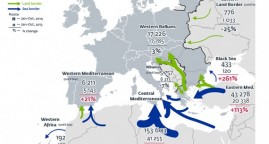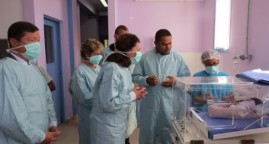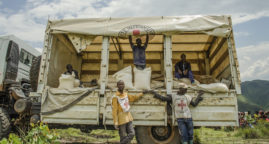Humanitarian corridors are helping change how Europeans see refugees
Article published on ICMC website on 10/23/2017
Largely unnoticed by the mainstream media, an innovative private-public initiative involving faith-based communities and government is facilitating refugees enter Europe since 2015.
The year 2015 saw an unprecedented number of refugees arriving in Europe. More than one million people were risking their lives to cross the Mediterranean Sea with thousands perishing in perilous journeys at the hands of people smugglers.
In many European countries, large numbers of ordinary people began welcoming the newcomers. Others, however, showed resistance to the arrival of people streaming through journeys fraught with danger. In some places, fences were erected.
In Italy, the Community of Sant’Egidio (link is external), together with the Federation of Evangelical Churches and the Waldensian Board, decided to create “humanitarian corridors” into the country.
Instead of walls and barriers, the initiative aimed to create a safe, government-backed way to enter the country for people fleeing from war and persecution. However, the promoters of the idea had to work hard to make it happen.
To begin with, the church groups “had to sign an agreement with both the Italian Home Office Ministry and the Ministry of Foreign Affairs,” explains Cesare Zucconi of Sant’Egidio. At first, adds Daniele Albanese of Caritas, “it was quite a hard job to convince the government to participate.”
Zucconi and Albanese were speaking at an 18-19 September conference on the role of Christian organizations in community-based sponsorship of refugees in Brussels.
The conference was organized by the Europe office of the International Catholic Migration Commission (ICMC) in cooperation with Caritas International Belgium (link is external) and the Churches’ Commission for Migrants in Europe (link is external) (CCME).
How humanitarian corridors work
The main goal of a humanitarian corridor program is to open up legal pathways so that refugees do not have to risk their lives to escape from harm or danger.
Completely self-financed, the humanitarian corridor involves local actors, parishes, and volunteers who will house and welcome the refugees. It thus mobilizes support by local populations and builds welcoming communities.
This community-backed sponsorship scheme is an addition to existing channels to receive refugees into the country, like government resettlement programs. Over the last two years, similar projects have started in other European countries.
The Italian initiative grants access to people in vulnerable conditions. Most are Syrians who have been living in precarious situations in Lebanon. Among them are victims of persecution, torture, and violence, as well as families with children, elderly or sick people, persons with disabilities. They enter Italian territory with humanitarian visas, where they apply for asylum.
Between February 2016 and August 2017, some 900 people arrived in Italy thanks to the humanitarian corridor. The initiative foresees the arrival of 1,500 people over three years.
The humanitarian corridor will now expand to Africa, offering a solution to refugees in Ethiopia. This is in response to a lack of legal pathways for African refugees, many of whom engage in dangerous land and sea crossings via Libya.
Once in Italy, the refugees are welcomed in private houses paid for by partner communities. They are taught Italian by volunteers who also help them to enroll their children in school and look for work. In this way, the program promotes their integration in Italy.
Travel costs, whether by ship or by plane, hospitality costs and the legal assistance expenses are covered by the sponsoring organizations, partly from church collections.
“It’s a safe solution for all,” says Paolo Naso of the Federation of Evangelical Churches. While “it opens new ways to safety for refugees, to avoid journeys of death,” the visa issuing procedures meet all the requirements by Italian authorities.
A new approach to integration
“This is a new approach to including refugees in the local community. When people arrive, they are welcomed by communities, not only by parishes but also by private citizens,” says Albanese. This bottom-up, community-based approach “can better integrate people” than other formal structures, he adds.
This new model of integration unlocks untapped resources that can be mobilized to welcome refugees. “We were amazed when a few weeks after launching the project we had the paradox of more people wanting to help [volunteer] than there were refugees,” Albanese recalls.
Members of the welcoming communities witness to the fact that “welcoming the refugees helped them foster community spirit and produced a change in them,” says Albanese. He emphasizes the importance of this change of narrative around refugees. “This helps to change the storytelling. So, there is a cultural change that happens.”
The changing views regarding the welcome and integration of newcomers are not going unnoticed.
“The European Union has recently acknowledged that private sponsorship not only promotes safe and regular pathways for refugees but also helps to raise public awareness and support for their cause,” says Petra Hueck, Director of ICMC Europe. “Since local communities are usually involved, the result is a more welcoming environment.”
The Italian humanitarian corridor program is funded through the country’s “8 x 1,000” (otto per mille) system. By virtue of the “otto per mille,” taxpayers contribute a compulsory 0.08% of their income for charity purposes but can choose which organizations receive it.
“If we talk about citizen engagement,” Hueck says, “it is very interesting to see that some Italian taxpayers are choosing to give this money to the humanitarian corridor project, instead of to other projects.”
To help disseminate the humanitarian corridor model alongside other legal channels for refugee admission, ICMC Europe has recently published a research paper on Private Sponsorship in Europe: Expanding complementary pathways for refugee resettlement.
Also in France
Last March, through an agreement with a coalition of Catholic and Protestant organizations, the French government gave its green light to implement humanitarian corridors in France.
The agreement “stipulates that within 18 months 500 people will be granted a long-stay visa enabling them to apply for asylum upon arrival in France,” explains Juliette Delaplace of Secours Catholique-Caritas France (link is external).
This program, too, offers a legal path to reach France in addition to other resettlement or humanitarian admission programs run by the government. The program has just begun, and the first 16 people arrived in July. “We expect new arrivals in October,” says Delaplace.
Like in Italy, the program is entirely funded by the involved organizations and its goal is to help people set themselves up and integrate. Local volunteer groups provide for daily expenses such as food, clothes, transportation and housing. “Beneficiaries have access to government allowances for asylum seekers as well as healthcare and public schooling,” notes Delaplace. “We are not a substitute for the public sector,” she adds.
In his remarks to the Brussels conference, Yuriy Tykhovlis, of the Migrants and Refugees Section of the Dicastery for the Promotion of Integral Human Development of the Holy See, emphasized the spiritual and faith foundation that makes community efforts possible and imperative.
Quoting Evangelii Gaudium, Pope Francis’ first apostolic exhortation, Tykhovlis said: “Solidarity cannot be reduced to a few ‘sporadic acts of generosity,’ for it demands ‘a new mindset which thinks in terms of community and the priority of the life of all over the appropriation of goods by a few’.”
Related Articles
EU and migrations
12/11/2015. This document analyzes the main migratory movements and their consequences in Europe.
Neonatal Equipment inauguration in Sainte Fleur pavilion
04/06/2016. Motherhood Sainte Fleur is a maternity managed by the French Order of Malta in Madagascar.
After Davos, let’s turn talk into action
01/29/2019. Combining humanitarian expertise, local know-how, and private sector acumen could help aid 800 million people around the world





